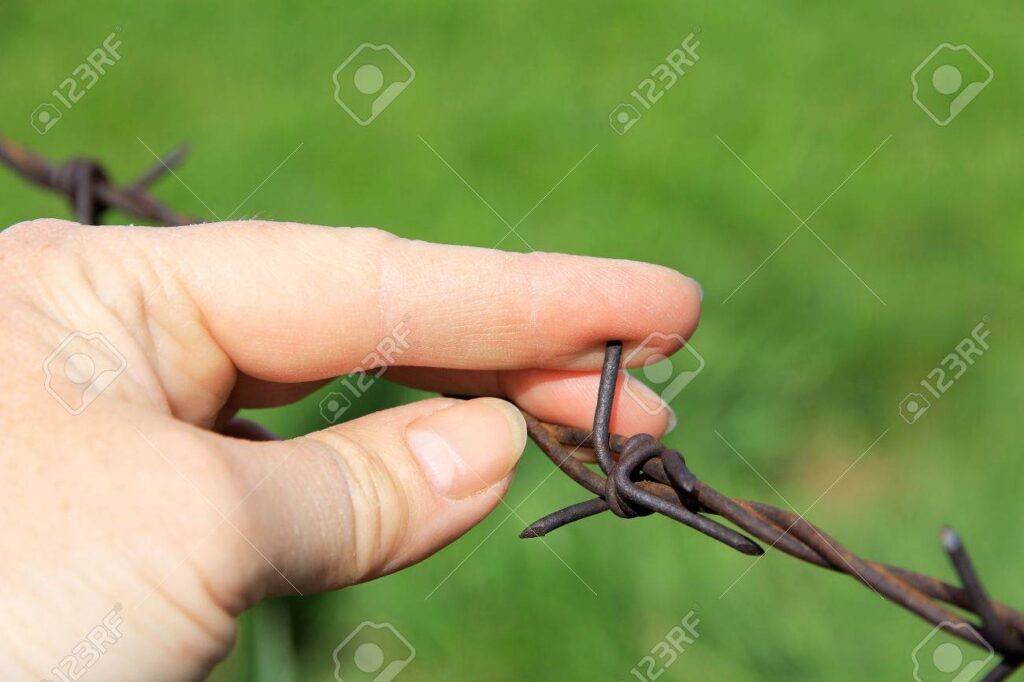
Barbed wire, a ubiquitous sight in fields, prisons, and security perimeters, is a formidable deterrent against unwanted intrusions. However, its very design, characterized by sharp, pointed barbs, poses a significant risk of injury to anyone who comes into contact with it. This article delves into the dangers associated with barbed wire, exploring the types of injuries it can inflict, the risks involved, and essential safety precautions to minimize the likelihood of encountering these potentially harmful consequences.
This comprehensive guide will examine the various ways barbed wire can cause harm, from minor cuts and abrasions to severe lacerations and deep wounds. We will also discuss the factors that contribute to the severity of these injuries and provide practical advice on how to prevent contact with barbed wire in the first place. Finally, we will outline the necessary steps to take if you or someone you know sustains a barbed wire injury, emphasizing the importance of seeking prompt medical attention.
Barbed Wire Injuries
Barbed wire injuries are a common occurrence, often resulting from accidental contact during outdoor activities, trespassing, or attempts to climb over fences. The sharp barbs can easily penetrate the skin, causing a range of injuries from superficial cuts to deep, penetrating wounds. The severity of the injury depends on several factors, including the type of barbed wire, the force of impact, and the location of the wound.
Types of Barbed Wire Injuries
- Cuts and Lacerations: These are the most common types of barbed wire injuries, often occurring when the barbs scrape against the skin. They can range in severity from minor scratches to deep, gaping wounds.
- Puncture Wounds: Barbed wire can penetrate the skin, creating deep puncture wounds that can damage underlying tissues, nerves, and blood vessels.
- Abrasions: These are superficial injuries that involve the removal of the outer layer of skin. They can be painful and prone to infection.
Risks of Barbed Wire Contact

The risks associated with barbed wire contact extend beyond the immediate physical injuries.
Infection
Barbed wire wounds are highly susceptible to infection due to the presence of dirt, debris, and bacteria introduced during the injury. The sharp barbs can also create deep, hard-to-clean wounds that provide an ideal environment for bacterial growth.
Tetanus
Tetanus is a serious bacterial infection that can occur when bacteria enter the body through a puncture wound. Barbed wire injuries, with their deep puncture potential, significantly increase the risk of tetanus.
Nerve Damage
The sharp barbs of barbed wire can damage nerves, leading to numbness, tingling, weakness, or even paralysis in the affected area.
Preventing Barbed Wire Injuries
Taking precautions to avoid contact with barbed wire is crucial for preventing injuries.
Awareness
Be aware of your surroundings and look out for barbed wire fences, especially in areas where you are unfamiliar.
Protective Gear
When working in areas with barbed wire, wear appropriate protective gear, such as thick gloves, long sleeves, and sturdy footwear.
Safe Practices
- Never attempt to climb over or crawl under barbed wire fences.
- Keep a safe distance from barbed wire fences.
- If you must work near barbed wire, use caution and wear appropriate safety equipment.
Medical Attention for Barbed Wire Wounds

If you or someone you know sustains a barbed wire injury, it is essential to seek prompt medical attention.
First Aid
- Control any bleeding by applying direct pressure to the wound.
- Clean the wound gently with soap and water.
- Cover the wound with a clean bandage.
- Seek medical attention immediately.
Medical Treatment
A medical professional will assess the severity of the wound and provide appropriate treatment, which may include:
- Cleaning and debridement of the wound
- Stitches or staples to close the wound
- Antibiotics to prevent infection
- Tetanus vaccination if necessary
Conclusion
Barbed wire, while effective as a deterrent, presents a significant risk of injury. Understanding the potential dangers, recognizing the types of injuries it can cause, and taking appropriate precautions are crucial for minimizing the likelihood of encountering these harmful consequences. If you or someone you know sustains a barbed wire injury, prompt medical attention is essential to ensure proper wound care, prevent infection, and minimize the risk of long-term complications.
